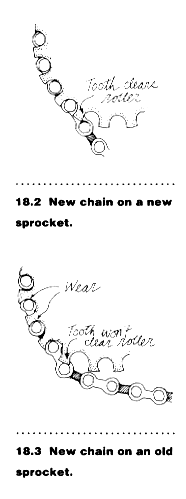
from the book Effective Cycling by John Forester page 168
New chains may run roughly on old sprockets (figures 18.2 and 18.3). The new chain may feel fine on the test stand as you twirl the pedals, but when you drive hard on the road your pedals may jump forward with loud clanking jerks. This is because the sprocket is worn to fit the longer links of the old worn-out chain. Look at the sprocket teeth. The backs of the sprocket teeth, and the fronts of the chainwheel teeth, wear into a hooko shape from contact with the chain under driving force. At a back sprocket, for instance, a link of the chain feeding onto the sprocket snugs down tightly into the hollows between the teeth. Then the next link feeding on just clears the top of the next tooth. As the chain wears into the root of the tooth, the clearance between the next link and the top of the next tooth gets les, but is compenstaed for by the lengthening of the links as they wear. When you put on a new chain its links are too short to clear the unworn tip of the next tooth. As long as the chain is under light load the chain roller rolls down the back side of the tooth, but when you drive hard the chain is snugged forward in the hollow and won't back off enough to let the roller roll over the point of the tooth. So the chain starts to run on the tips of the teeth. When the sprocket turns enough so the chain feeds off the teeth in front of this bulge in the chain, suddenly you are tring to drive with a chain resting on the tips of the teeth. The chain slips forward untili it catchs in the next tooth forward with a jerk and a clank.
